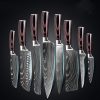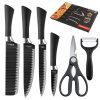If you’re wondering how to choose a chef knife, there are numerous factors to consider, such as weight, sharpness, material and balance. It’s also worth examining what cooking style you’re using the knife for.
For every job there’s a perfect tool, and a chef is only as sharp as their knife.
A knife is the simplest of utensils and yet, the deeper you look the more choice there is: Your budget? Your favourite cuisine? What is important to you? Which style, material or size is best?
From the bottom of the handle to the very tip of the blade, you will find a reflection of the knife designer’s vision. So, here’s a guide to get you started, beginning with the difference between stamped and forged blades.
Stamped vs Forged
Forging a blade involves using a mould and creating the knife from scratch in its liquid metal form. Typically, a forged knife blade will run the entire length of the knife from the handle. T
A forged blade knife is substantial and durable, but more expensive than a stamped blade. Professional chefs’ knives tend to be made this way.
Chances are, you’ve held a knife that’s been stamped in the manufacturing process. Stamping, in this context, is cutting the knife from an existing sheet of metal. These knives are cheaper and less durable.
Blade Material
Stainless steel
A common household material: It’s probably in your kitchen drawer at home. This is a relatively inexpensive metal and is rust-resistant, though the blade dulls easily and can be difficult to sharpen.
High-carbon steel
Pricier than standard stainless steel, high-carbon steel blades are robust and maintain their edge and sheen better than their cheaper counterparts.
Titanium
These blades can be effectively sharp, relatively light and comfortable to use. However, their flexibility means they’re not ideal for cutting dense or hard materials.
Ceramic
A knife with a ceramic blade will maintain its sharpness for a long time. And a well-made one is beautifully precise. However, they lack the weight and thick heel of other knives and are more fragile than high-end metals. While not quite versatile, a good ceramic knife is an effective weapon in the chef’s arsenal.
Weight
Weight is subjective for a chef: What’s satisfyingly hefty for one cook is awkward and cumbersome for another. A heavy knife can be ideal for breaking down hard, root vegetables or even through dense meat and poultry bone. While a lighter one is suited to fast-chopping more brittle ingredients. Ideally, you should have both, but if you’re only investing in one, consider the kind of cooking you do and the kind of weight you find comfortable.
If you can’t hold the knife before buying it, for instance if you were to purchase it online, online purchasing for instance, then do some research on the brand and model’s weight. Weight can have a bearing on balance. Speaking of which…
Balance
Balance is in the palm of the beholder and can be judged two ways: As you hold a knife pointing the tip away from your torso, it shouldn’t require excess strain to hold it straight. And, when holding it perpendicular to yourself (the blade being at a right angle to your arm), it should also be easy to maintain an even keel.
Do you chop or slice more?
This comes down to a few factors: Are you buying more than one knife? And if you’re only buying one, what – specifically – will you be using it for?
A narrower blade is more suited to slicing; while a broader blade is better for chopping. Curved blades can be “rocked” to cut softer foods rapidly, but they tend to be thinner and thus less suited to heavy cutting.
Japanese Knives
Growing in popularity around the world, Japanese knives are light, very sharp and thinner than western counterparts. Their lightness allows for dexterity and speed, though a Japanese knife will have trouble coping with tougher surfaces like bone or dense vegetables.
However, some principles of Japanese blade manufacturing have crossed over to mainstream, western use, and some of the best chef knives are hybrids, combining the sharpness of a Japanese blade with the industrial practices of German manufacturing.
Maintenance
Naturally, you should clean and dry your knives after every use. If you’ve invested in good knives, you shouldn’t need to sharpen them too often, and you should know whether it needs a sharpening upon use (if it the slice is more serrated than intended, for instance, or slower). You can also test a blade, old or new, by slicing through a piece of paper. The cleaner the cut, the sharper the blade. Blades can be sharpened on stone or other metals.
For Professionals
There are always differences in cost when purchasing either amateur or professional level equipment – regardless of the industry. So, it shouldn’t be surprising that chef’s knives are a bigger commitment than consumer ones: More is demanded of them when it comes to sharpness, metal quality, durability and ease of use.
Le Cordon Bleu sells its own range of acclaimed chef’s knives, made in collaboration with Zwilling. And many passionate foodies have enjoyed Le Cordon Bleu’s Chef Knife Skills Course, which teaches everything from choosing to handling to fish-filleting. This course is accessible to cooks of any level – a primer for those who want to master the blade.

